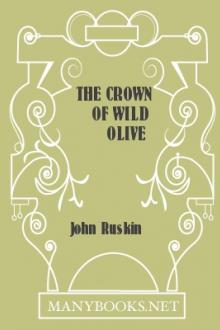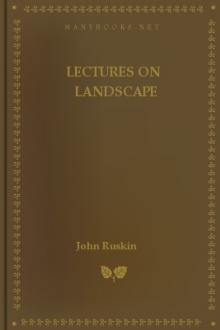The Crown of Wild Olive by John Ruskin (a court of thorns and roses ebook free .TXT) 📕

- Author: John Ruskin
- Performer: -
Book online «The Crown of Wild Olive by John Ruskin (a court of thorns and roses ebook free .TXT) 📕». Author John Ruskin
It is not, however, only in invention that men over-work themselves, but in execution also; and here I have a word to say to the Pre-Raphaelites specially. They are working too hard. There is evidence in failing portions of their pictures, showing that they have wrought so long upon them that their very sight has failed for weariness, and that the hand refused any more to obey the heart. And, besides this, there are certain qualities of drawing which they miss from over-carefulness. For, let them be assured, there is a great truth lurking in that common desire of men to see things done in what they call a "masterly," or "bold," or "broad," manner: a truth oppressed and abused, like almost every other in this world, but an eternal one nevertheless; and whatever mischief may have followed from men's looking for nothing else but this facility of execution, and supposing that a picture was assuredly all right if only it were done with broad dashes of the brush, still the truth remains the same:—that because it is not intended that men shall torment or weary themselves with any earthly labor, it is appointed that the noblest results should only be attainable by a certain ease and decision of manipulation. I only wish people understood this much of sculpture, as well as of painting, and could see that the finely finished statue is, in ninety-nine cases out of a hundred, a far more vulgar work than that which shows rough signs of the right hand laid to the workman's hammer: but at all events, in painting it is felt by all men, and justly felt. The freedom of the lines of nature can only be represented by a similar freedom in the hand that follows them; there are curves in the flow of the hair, and in the form of the features, and in the muscular outline of the body, which can in no wise be caught but by a sympathetic freedom in the stroke of the pencil. I do not care what example is taken, be it the most subtle and careful work of Leonardo himself, there will be found a play and power and ease in the outlines, which no slow effort could ever imitate. And if the Pre-Raphaelites do not understand how this kind of power, in its highest perfection, may be united with the most severe rendering of all other orders of truth, and especially of those with which they themselves have most sympathy, let them look at the drawings of John Lewis.
These then are the principal lessons which we have to learn from Turner, in his second or central period of labor. There is one more, however, to be received; and that is a warning; for towards the close of it, what with doing small conventional vignettes for publishers, making showy drawings from sketches taken by other people of places he had never seen, and touching up the bad engravings from his works submitted to him almost every day,—engravings utterly destitute of animation, and which had to be raised into a specious brilliancy by scratching them over with white, spotty lights, he gradually got inured to many conventionalities, and even falsities; and, having trusted for ten or twelve years almost entirely to his memory and invention, living I believe mostly in London, and receiving a new sensation only from the burning of the Houses of Parliament, he painted many pictures between 1830 and 1840 altogether unworthy of him. But he was not thus to close his career.
In the summer either of 1840 or 1841, he undertook another journey into Switzerland. It was then at least forty years since he had first seen the Alps; (the source of the Arveron, in Mr. Fawkes's collection, which could not have been painted till he had seen the thing itself, bears date 1800,) and the direction of his journey in 1840 marks his fond memory of that earliest one; for, if we look over the Swiss studies and drawings executed in his first period, we shall be struck with his fondness for the pass of the St. Gothard; the most elaborate drawing in the Farnley collection is one of the Lake of Lucerne from Fluelen; and, counting the Liber Studiorum subjects, there are, to my knowledge, six compositions taken at the same period from the pass of St. Gothard, and, probably, several others are in existence. The valleys of Sallenche, and Chamouni, and Lake of Geneva, are the only other Swiss scenes which seem to have made very profound impressions on him.
He returned in 1841 to Lucerne; walked up Mont Pilate on foot, crossed the St. Gothard, and returned by Lausanne and Geneva. He made a large number of colored sketches on this journey, and realised several of them on his return. The drawings thus produced are different from all that had preceded them, and are the first which belong definitely to what I shall henceforth call his Third period.
The perfect repose of his youth had returned to his mind, while the faculties of imagination and execution appeared in renewed strength; all conventionality being done away with by the force of the impression which he had received from the Alps, after his long separation from them. The drawings are marked by a peculiar largeness and simplicity of thought: most of them by deep serenity, passing into melancholy; all by a richness of color, such as he had never before conceived. They, and the works done in following years, bear the same relation to those of the rest of his life that the colors of sunset do to those of the day; and will be recognised, in a few years more, as the noblest landscapes ever yet conceived by human intellect.
Such has been the career of the greatest painter of this century. Many a century may pass away before there rises such another; but what greatness any among us may be capable of, will, at least, be best attained by following in his path; by beginning in all quietness and hopefulness to use whatever powers we may possess to represent the things around us as we see and feel them; trusting to the close of life to give the perfect crown to the course of its labors, and knowing assuredly that the determination of the degree in which watchfulness is to be exalted into invention, rests with a higher will than our own. And, if not greatness, at least a certain good, is thus to be achieved; for though I have above spoken of the mission of the more humble artist, as if it were merely to be subservient to that of the antiquarian or the man of science, there is an ulterior aspect in which it is not subservient, but superior. Every archæologist, every natural philosopher, knows that there is a peculiar rigidity of mind brought on by long devotion to logical and analytical inquiries. Weak men, giving themselves to such studies, are utterly hardened by them, and become incapable of understanding anything nobler, or even of feeling the value of the results to which they lead. But even the best men are in a sort injured by them, and pay a definite price, as in most other matters, for definite advantages. They gain a peculiar strength, but lose in tenderness, elasticity, and impressibility. The man who has gone, hammer in hand, over the surface of a romantic country, feels no longer, in the mountain ranges he has so laboriously explored, the sublimity or mystery with which they were veiled when he first beheld them, and with which they are adorned in the mind of the passing traveller. In his more informed conception, they arrange themselves like a dissected model: where another man would be awe-struck by the magnificence of the precipice, he sees nothing but the emergence of a fossiliferous rock, familiarised already to his imagination as extending in a shallow stratum, over a perhaps uninteresting district; where the unlearned spectator would be touched with strong emotion by the aspect of the snowy summits which rise in the distance, he sees only the culminating points of a metamorphic formation, with an uncomfortable web of fan-like fissures radiating, in his imagination, through their centres[104]. That in the grasp he has obtained of the inner relations of all these things to the universe, and to man, that in the views which have been opened to him of natural energies such as no human mind would have ventured to conceive, and of past states of being, each in some new way bearing witness to the unity of purpose and everlastingly consistent providence of the Maker of all things, he has received reward well worthy the sacrifice, I would not for an instant deny; but the sense of the loss is not less painful to him if his mind be rightly constituted; and it would be with infinite gratitude that he would regard the man, who, retaining in his delineation of natural scenery a fidelity to the facts of science so rigid as to make his work at once acceptable and credible to the most sternly critical intellect, should yet invest its features again with the sweet veil of their daily aspect; should make them dazzling with the splendor of wandering light, and involve them in the unsearchableness of stormy obscurity; should restore to the divided anatomy its visible vitality of operation, clothe naked crags with soft forests, enrich the mountain ruins with bright pastures, and lead the thoughts from the monotonous recurrence of the phenomena of the physical world, to the sweet interests and sorrows of human life and death.
THE END.[97] It was not a little curious, that in the very number of the Art Union which repeated this direct falsehood about the Pre-Raphaelite rejection of "linear perspective" (by-the-bye, the next time J. B. takes upon him to speak of any one connected with the Universities, he may as well first ascertain the difference between a Graduate and an Under-Graduate), the second plate given should have been of a picture of Bonington's,—a professional landscape painter, observe,—for the want of aërial perspective in which the Art Union itself was obliged to apologise, and in which the artist has committed nearly as many blunders in linear perspective as there are lines in the picture.
[98] These false statements may be reduced to three principal heads, and directly contradicted in succession.
The first, the current fallacy of society as well as of the press, was, that the Pre-Raphaelites imitated the errors of early painters.
A falsehood of this kind could not have obtained credence anywhere but in England, few English people, comparatively, having ever seen a picture of early Italian Masters. If they had, they would have known that the Pre-Raphaelite pictures are just as superior to the early Italian in skill of manipulation, power of drawing, and knowledge of effect, as inferior to them in grace of design; and that in a word, there is not a shadow of resemblance between the two styles. The Pre-Raphaelites imitate no pictures: they paint from nature only. But they have opposed themselves as a body to that kind of teaching above described, which only began after Raphael's time: and they have opposed themselves as sternly to the entire feeling of the Renaissance schools; a feeling





Comments (0)